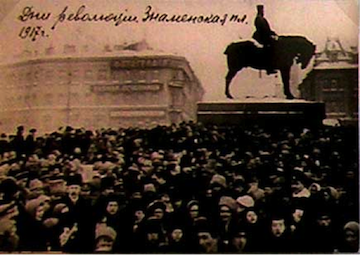

|
The February Days On 23 February, International Women's Day, a large crowd of women marched along Nevsky Prospekt to protest for equal rights. They were joined by workers from the city's Vyborg district protesting against the bread shortages. There were clashes with the Cossacks and police by City Hall before the crowds dispersed. The next morning 150,000 workers took to the streets - some armed with spanners and pieces of iron to fight the soldiers brought in overnight to bar their way and to loot the well-stocked food shops of the city centre. They were joined by people of all classes in a huge rally on Znamenskaya Square. In full view of the powerless police, revolutionary orators addressed the crowd from the equestrian statue of Alexander III, which they engraved with the graffiti 'Hippopotamus', the people's nickname for this awesome but ridiculous monument to autocracy.  Znamenskaya Square during the February Days Emboldened by the absence of repressive measures, even larger crowds came out on 25 February. It was a general strike. The demonstrations now had a more political character. Red flags and banners began to appear. There were violent clashes with the police but the demonstrators tried to win the soldiers over to their side. The authorities could have contained the situation if they had avoided open conflict with the crowds. With bread delivered to the shops, the demonstrations might have lost momentum, as bread riots had done previously. Shliapnikov, the leading Bolshevik in the capital, scoffed at the idea that this was the start of a revolution: 'Give the workers a pound of bread and the movement will peter out', he told his fellow Bolsheviks on 25 February. The next day the police and soldiers fired at the crowds. Fifty people were killed on Znamenskaya Square. Angry demonstrators broke into the barracks of the Pavlovsky Regiment, whose soldiers, shaken by the news, joined them in a mutiny and clashed with the police. On 27 February the mutiny spread to other regiments, whose soldiers came onto the streets to join the people's side in fights against the loyalist regiments and the police. The mutiny of the Petrograd garrison turned the disorders of the previous four days into a full-scale revolution. The tsarist authorities were virtually deprived of military power in the capital. The spilling of the soldiers onto the streets gave a military strength and organization to the revolutionary crowds. |
© 2014 Orlando Figes | All Rights Reserved